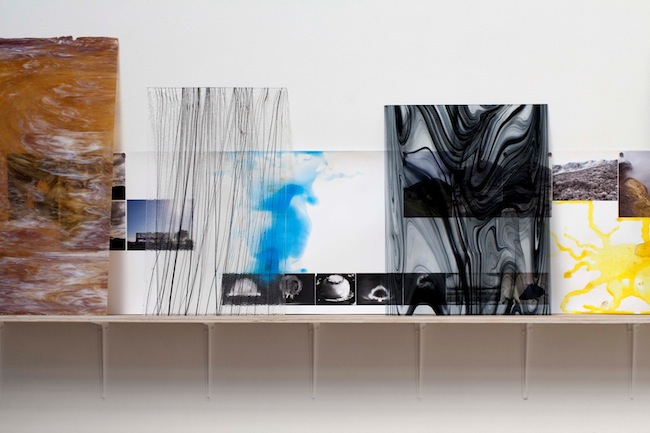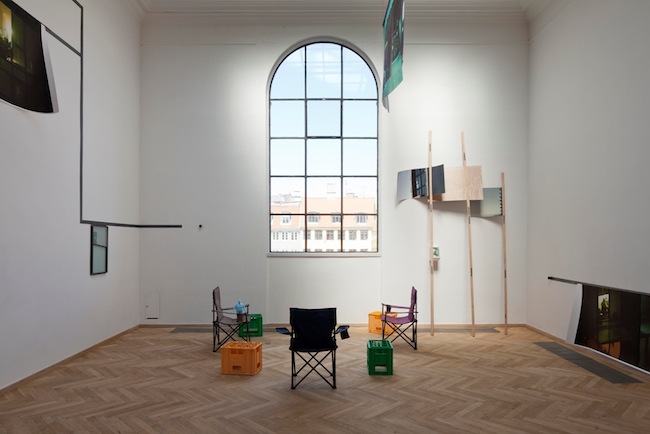
A Work of Art Is a Temporary Thing
05/07/2012
Photos: Anders Sune Berg
Through August 5, the contemporary art space Kunsthal Charlottenborg in Copenhagen is presenting Christina Mackie's (1956) solo show. This is the first showing in Scandinavia for the artist, who was born in Oxford, raised in Canada, and now lives in London. Titled “Painting the Weights”, the exhibition is one of Mackie's many long-term research projects on natural materials and technologies, and the connections between nature, people and societies.

Mackie uses extremely varying forms of expression and materials – anything can become a medium for her: a drawing, watercolors, a found object, an installation, ceramics, photographs, or even three-dimensional animation. Variously combining these elements, she forms a collection. The relationships between these materials form the main body of her exhibit and the composition – which is at once whole and fragmented; it comes apart, and then binds together again. In the press release, “Painting the Weights” is described as an installation that consists of two parts: the first part reflects the artist's studio, with makeshift tables and shelves on which objects both created and found by Mackie are displayed; the second is composed of scaffolding, used to display large-format photographs of lonely figures staying at a residence.
Mackie's main weapon is the combination and connecting of elements. Every exhibition differs in terms of composition – the relationships between the materials are one-of-a-kind, unrepeatable. A wooden box full of tiny objects, a covered glass dish, a spray bottle, a picture of an atomic mushroom cloud, lumps of clay, purple mounds of sand, wooden planks with improvised faces, images of jelly-fish, computer monitors – it's like a cabinet of curiosities. The question may arise – How can there possibly be some sort of relationship between all of these things? But we're not talking about a cabinet of curiosities here, but rather a modeling of relationships; possibly, even symbolic connections that form between things.
One of the artist's points of focus is trestle art, i.e, art that is variable, changeable – it's not fixed, it can be taken apart. “There are intricate relationships between all of the elements, they are chosen in a particular order to accommodate the natural laws at play that I see in the overall pieces. The work is always temporary. You bring it together only for a moment, and then it’s gone,” explains Mackie.

Mediations (not to be confused with meditations) of objects and things, and the interaction and mutual relationships between a space and locations within it, are one of the themes of this year's international contemporary art exhibition, dOCUMENTA(13). Although Mackie didn't participate, it seems as if her fascination with the materialistic – and its power and influence in forming the past, the present and the future – would dialog perfectly with the works done by other artists there. Whatever the real situation may be, this is why it is so tempting to talk about Mackie's works in the context of the conceptual conditions (if they can be so called!) set up by dOCUMENTA(13). As the curator of the exhibition, Carolyn Christov-Bakargiev, writes in her lengthy essay cum press-release: “A worldly intra-action with materials, objects, other animals and their perceptions, suggests forms of de-symbolization and disowning knowledge and notions of property, as well as providing the possibilities of a slower form of time – the time of materials. This involves reconnecting people with their ancient knowledge of directly caring for their own sustenance and food (..), as well as forms of degrowth, alternatives to financial exchange, as in time banks or barter economies, establishing possibilities for relations and intra-actions with all things that are not digital.” (The dance was very frenetic, lively, rattling, clanging, rolling, contorted, and lasted for a long time, 2012) Bringing into focus searches for alternative ways of life, dOCUMENTA(13) takes on a position of a known form of escapism, and at the same time, the role of challenger, by raising the question of how much, and in what way, are we addicted to systems of our own creation – market, economic, social and political – as well as to virtual environments and digital technologies. This question is also aimed at art, which has now become an essential part of the consumer sphere.
Christina Mackie's title work, the video animation “Painting the Weights”, brings the virtual environment to the forefront. The power of the medium is not subjected to critique, but rather serves as a weapon with which to illustrate the structures of relationships. In it, we see objects levitating in a room, completing one another, and then disappearing. Basically, the work is about how objects react in relationship to one another: whether they are soft, hard, heavy or brutal. In interviews, Mackie often stresses the temporariness of materials – how they waste away, disappearing and evaporating – including the internet and all of the forms and objects that surround us. Everything turns to dust – the physical falls apart, information is lost; this is where the title “Painting the Weights” come from. “I was thinking about all the material in my studio – not just artworks, but all of the junk that amasses there – and its eventual aspect as dust. I decided to make a short film about that. I started asking around about how I could turn objects into dust with animation, and a number of people came back to me saying ‘your problem will be when it comes to painting the weights’, which is the working term for giving the images physical attributes,” reveals Mackie.
Here the artist serves out another explanation, pointing out the connotations with waiting, which is one of the intrinsic aspects in her creative practice – “waiting how things organize themselves, one after the other”. She has embodied this principle in her piece, “Us, the Residents”, which came about while she resided in an apartment block complex in Melbourne. All of the images, in which we see both Mackie and other residents, were taken from her room's balcony. She describes it as a time when she, just like the others, spent all of her waking hours at the computer or the television, watching all of the “garbage” that they show. Being in an unchanging place like this for a short amount of time, people find themselves in an interstitial position that is largely artificial – they have no interest in bettering the environment around them, for instance, sprucing up the interior, because soon enough, they'll be leaving. They spend their days doing the same thing – mostly working, waiting, wishing for something, or just bored. It's a temporary, transitional stage; short and without any expectations in relation to permanency.

There is much of the mystical and unexpected in the way that things and objects grow out of one another, how they complete and compete against one another, and how they reveal and hide one another. The same can be said about how theses things become discoveries, intermediaries and guides to something else; or, even the complete opposite – nuisances, mistakes, hindrances. Quite possibly, a good way in which to discuss this is with the help of a mediator, as the curators Søren Andreasen and Lars Bang Larsen propose: “Everything becomes what it is through mediations, conceived as connections within the processes that establish things. In the Hegelian sense, mediation describes the tension of the process of becoming. This is unlike a relation that is static and fixed. A relation is ready, whereas mediation is something that is in the making, is being produced, that has not yet found stability.” (The Critical Mass of Mediation, 2012)